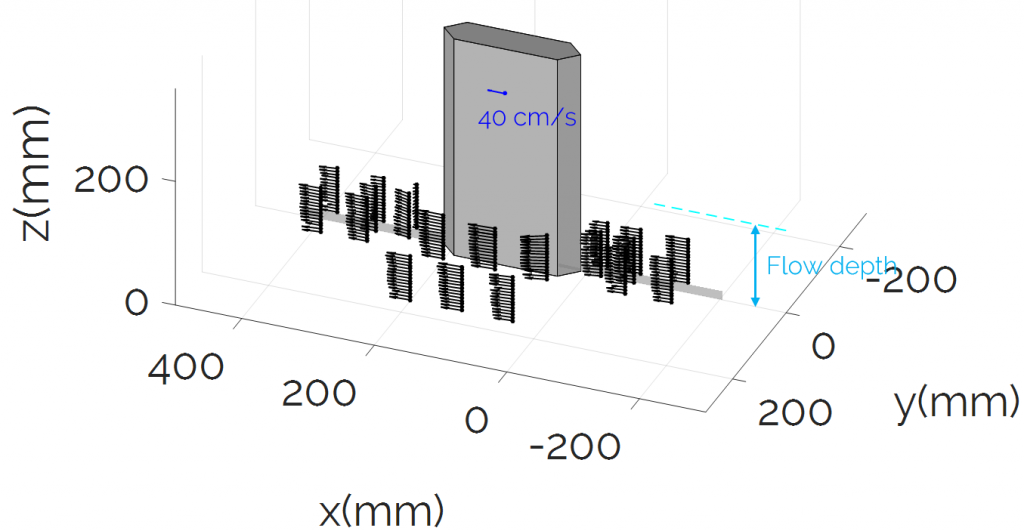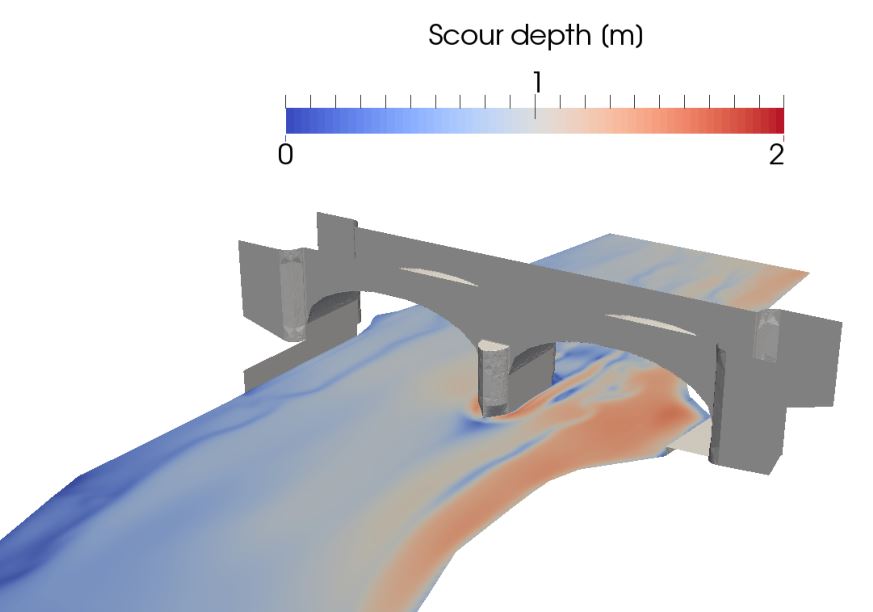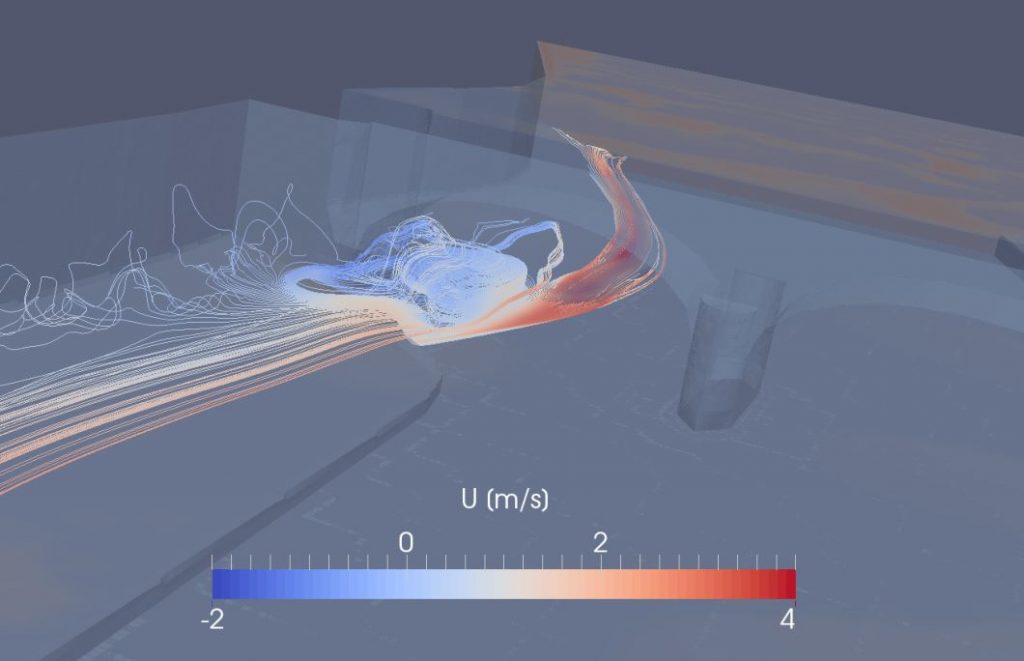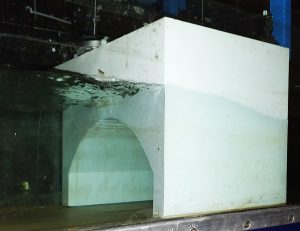On 21st November 2019, a webinair about scour at bridges has been presented by CIRIA with the aim to update the existing Scour Guidance CIRIA C742: Manual on scour at bridges and other hydraulic structures (2015). Dr Prakash Kripakaran presented the results from research at the University of Exeter and how these have been included in scour assessment practice within the framework of Highways England’s BD97/12. The webinair can be accessed here.
Scour Assessment Workshop in Bristol
Featured
On 16th December 2019, the research team from the University of Exeter (Dr Diego Panici and Dr Prakash Kripakaran) and the industry partner of Devon County Council (Mr Kevin Dentith and Mr Simon Hollyer) presented the outcome of the research on the effects of debris accumulations on bridge scour with practical applications on case-studies. The workshop showed the methodology developed by the research team, which includes the estimation of the size of debris accumulated at bridges and the scour depth induced by such accumulations. The event was specifically designed for practitioners (e.g. local councils, Highways England), since this methodology is being included in Highways England’s new Design Manual for Roads and Bridges (DMRB). The presentations from the research team are available here.
Dissemination workshop | update
Featured
We hosted a successful dissemination workshop on our project on October 31, 2018 in Exeter. The event was attended by a number of industry practitioners including local authorities, consultants and stakeholder groups and also by few members from academia. Copies of the slides and agenda are available below. Please get in touch with us if you are interested in finding out more about our project.
Dissemination workshop
Featured
Please use this form to indicate your attendance. It is free.
On 31 October 2018, we will have a workshop at the University of Exeter on Assessment of Debris Related Scour Risks to Bridges. The workshop will present a new approach for assessing the scour risks due to debris blockage at bridge piers. This approach is in the process of becoming embedded as part of (i) C742: CIRIA manual for scour at bridges and hydraulic structures findings and (ii) BD97: the Highways England guidance for assessing scour risks for bridge structures. The approach and other findings to be presented at this workshop are outputs from an EPSRC-funded Project titled “Risk Assessment of Masonry Bridges under Flood Conditions: Hydrodynamic Effects of Debris Blockage and Scour”.
Followings are details and directions.
Date:
- Wednesday 31 October 2018 (10:00 – 16:00)
Venue:
- University of Exeter (UoE), Reed Hall (EX4 4QR) – Ibrahim Ahmed Room (http://www.reedhall.co.uk/contact-us/find-us/)
- University of Exeter (UoE), Harrison Building (for optional tour to the Fluids Lab at the end of the workshop).
Project description
Featured
RAMB project is funded by EPSRC as shown in here. It is aimed at studying hydrodynamics and scour around masonry bridges due to debris blockage, which has been identified as a major cause of bridge failure during flooding. Debris can reduce conveyance capacity, enhance scour and increase hydrodynamic forces, which in turn may detrimentally affect bridge stability even under moderate flow rates. Debris build-up can occur around any obstruction to water flow such as bridge piers. Masonry bridges, which constitute over 40% of the nation’s bridge stock, are particularly susceptible to debris blockage due to their short spans and low clearances over water levels. While hydrodynamic effects due to debris are known to significantly heighten the chances of bridge failure by worsening pier scour and constricting flow, current guidance for design and assessment of bridges are highly inadequate for evaluating effect of debris on scour and also hydrodynamic loading at bridges.
This research will directly address this urgent and practical need for an approach to evaluate the risks from debris accumulation at bridges. It will investigate the scour-enhancing effects of debris accumulation in the watercourse, and devise a systematic methodology to assess scour enhancing effect of debris blockage on bridge piers. The methodology, which will be built into existing CIRIA guidance [1] for assessment of bridges under hydraulic action, will enable optimal planning of interventions to effectively target bridges at risk to debris blockage and thereby improve resilience of the transport network and the rate of post-flood recovery. RAMB project also investigate hydrodynamic pressures at arch bridges which can be of practical importance for maintenance of masonry arch bridges.
This research comprises of the following three key elements
- Froude-scale hydraulic experiments to depict effects of debris blockage on flow parameters and pier scour;
- CFD modelling to simulate flow under masonry bridges and around bridge piers with floating debris blockage; and
- Formulation of a risk-based strategy to assess the hydrodynamic effects of debris accumulation at bridges.
[1] Kirby et al. (2015), Manual on scour at bridges and other hydraulic structures, second edition
Research team
The research team is composed of the following institutions and individuals:
* University of Exeter, Centre for Water Systems
Prof Slobodan Djordjevic: principal investigator and leading the experimental phase 
Prof Gavin Tabor: leading the CFD modelling phase of the project 
Dr Prakash Kripakaran: expert on bridge management and leading the third phase of the project 
Dr Mohsen Ebrahimi: former research fellow & physical (experimental) modeller; currently River Scour Specialist at Mott MacDonald

Dr Recep Kahraman: research fellow & CFD modeller
Matthew Riella: PhD researcher in CFD
Bernardas Jankauskas: PhD researcher in CFD
* Heriot-Watt University
Prof Scott Arthur: leading expert in debris modelling
* University of Belgrade
Prof Dušan Prodanović: expert and advisor in experimental hydraulics
Computational modelling
This phase will focus on the application of CFD to predict hydrodynamic effects of debris blockage for a broad range of bridges. We will evaluate computationally the two main hydrodynamic effects on a bridge, namely scour and pressures. Two distinct approaches to modelling scour will be investigated and later compared for their effectiveness. Results from the flume experiments in Phase 1 will be used to test and validate the CFD models. Accuracy and computational costs of the two distinct approaches for scour prediction and modelling will be assessed to determine the most suitable approach for the next stage of the project.
Scour depths will be empirically related to flow velocities near piers or abutments based on results from the scour modelling approach identified as the most suitable for scour prediction. We will then use full scale CFD simulations to predict debris effects for a diverse set of debris and bridge scenarios. This research will is interested in mainly evaluating the interactions between model parameters such as bridge span and pier width that largely determine the two quantities of interest – flow velocities and pressures. Results from the CFD models, which will include flow velocities around piers and abutments, and pressure distributions on the bridge superstructure, will be compiled for use in Phase 3.
In the following results from a sample CFD simulation (using OpenFOAM) is shown.
In the following simulated scour maps for a two-span arch bridge is shown.
And a looking upstream view of flow streamlines:
Phase 3. Assessment guidance development
This phase focuses on the development of a new model for assessing debris-induced scour at bridges. This method integrates with current approaches to improve scour estimations at bridge piers. RAMB project also provides insights for evaluating hydrodynamic pressure at arch bridges.
Effect of debris on scour
To include effect of debris accumulation on local scour depth, we propose a new model instead of “equivalent pier width” approach. This will enable a more accurate and realistic estimation of the depth of local scour with debris accumulation. The proposed model is developed using not only data from our in-house flume experiments, but also most of available experimental data in literature. Also, in contrast to the “equivalent pier width” method, the model is not restricted to floating debris but is also applicable to cases where debris is submerged or resting on the bed.
We introduce a new factor Φdebris, derived via multivariate regression analysis, to be incorporated into any scour estimation equation. For instance, equation in CIRIA C742 will be modified as
Ys/Bs = Φshape.Φdepth.Φvelocity.Φangle.Φdebris
where Ys = scour depth; Bs = pier width; and Φdebris is a debris factor identified based on debris dimensions and elevation.
Hydrodynamic pressure on the arch sofit
We have studied hydrodynamic pressures at a single span arch bridge under inundation conditions using a 1:10 scaled model (following schematic). We particularly measured hydrodynamic pressures at the arch soffit surface (enclosed by green circle in the following figure) using miniature pressure transducers.
We detected large negative pressure (suction in order of upto ~ 3 times the hydrostatic pressure) at the surface of arch soffit. This was a rather surprising finding since negative pressure was not detactable by underwater visual inspection. We identified this to be matching with the observations by practitioners who have diagnosed arch soffit surface often prone to suction and mortar loss. Based on this, we are proposing to do closer post-flood inspection of this location to detect any likely mortar loss and repair it before affecting the structural integrity of the bridge.
Sample results
Scour maps in single-pier experiments with a log debris at free surface (top) and on bed (bottom). Flow is from left to right.
Scour maps in single span-arch experiments with and without log debris . Flow is from right to left.
Followings are a few photos showing our recent activities in flume experiments (flow is from right to left).
Following photo illustrates pressure sensors embedded in a pier model for measuring hydrodynamic pressure (acoustic Doppler velocimeter (ADV) can be also seen on the left side).
Velocity vector field measured around a pier using ADV. 
Power spectral density plot at a point adjacent to the bridge pier.
Scour protection using riprap around a pier blocked by a log debris (not shown in the image). Flow is from left to right.
ISHS 2018
Dr Mohsen Ebrahimi presented our paper “Experimental Investigation of Scour and Pressures on a Single Span Arch Bridge Under Inundation” on 16th of May at ISHS 2018 in Aachen.
Paper in ASCE Journal of Hydraulic Engineering
Our paper “Experimental Study on Scour at a Sharp-Nose Bridge Pier with Debris Blockage”, Ebrahimi et al. (2018), is in press in the ASCE Journal of Hydraulic Engineering. The paper discusses effect of debris on scour in shallow and deep flows and provides insights on the effect of debris elevation (in water column) on scour depth at a sharp-nose bridge pier.



















